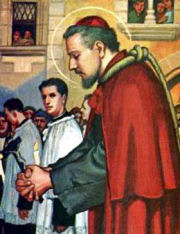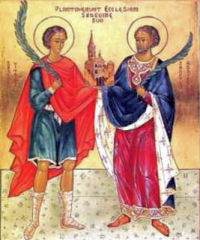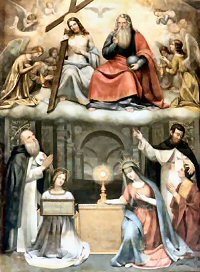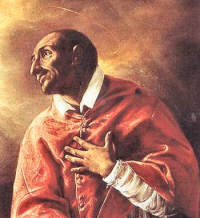Ordinary Time: November 4th
Memorial of St. Charles Borromeo, bishop
Other Commemorations: Sts. Vitalis and Agricola, Martyrs (RM); St. Felix of Valois (RM);
» Enjoy our Liturgical Seasons series of e-books!
St. Charles Borromeo (1538-1584) was a member of a noble family and a nephew of Pope Pius IV. He was made a Cardinal at the age of 23 and assisted the Pope in administering the affairs of the Holy See and in governing the Church. Soon thereafter he was made Archbishop of Milan. His endeavors on behalf of the 19th Ecumenical Council of Trent (1545-1564) were especially meritorious and fruitful. He helped to direct and guide it and bring it to a successful conclusion. He then proceeded to enforce its decrees in the Archdiocese of Milan and thoroughly reformed Catholic life in his See. During a plague he walked barefooted in the public streets, carrying a cross, with a rope around his neck, offering himself as a victim to God for the transgressions of his people.
According to the 1962 Missal of St. John XXIII the Extraordinary Form of the Roman Rite, today is the commemoration of Sts. Vitalis and Agricola, martyrs in Bologna.
Don't forget to pray for the Poor Souls in Purgatory from November 1 to the 8th.
St. Charles Borromeo
 Charles Borromeo, the bishop of Milan, came from a wealthy, aristocratic Italian family. He was born in the family castle, and lived a rather lavish life, entertaining sumptuously as befit a Renaissance court. He personally enjoyed athletics, music, art, and the fine dining that went along with lifestyles of the rich and famous of the sixteenth century. His maternal uncle, from the powerful Medici family, was pope. As was typical of the times, his uncle-pope made him a cardinal-deacon at age twenty-three and bestowed on him numerous offices. He was appointed papal legate to Bologna, the Low Countries, and the cantons of Switzerland, and to the religious orders of St. Francis, the Carmelites, the Knights of Malta, and others.
Charles Borromeo, the bishop of Milan, came from a wealthy, aristocratic Italian family. He was born in the family castle, and lived a rather lavish life, entertaining sumptuously as befit a Renaissance court. He personally enjoyed athletics, music, art, and the fine dining that went along with lifestyles of the rich and famous of the sixteenth century. His maternal uncle, from the powerful Medici family, was pope. As was typical of the times, his uncle-pope made him a cardinal-deacon at age twenty-three and bestowed on him numerous offices. He was appointed papal legate to Bologna, the Low Countries, and the cantons of Switzerland, and to the religious orders of St. Francis, the Carmelites, the Knights of Malta, and others.
When Count Frederick Borromeo passed away, many people thought Charles would give up the clerical life and marry now that he had become head of the Borromeo family. But he did not. He deferred to another uncle and became a priest. Shortly thereafter he was appointed bishop of Milan, a city that had not had a resident bishop for over eighty years.
Although raised to the grand life, Borromeo spent much of his time dealing with hardship and suffering. The famine of 1570 required him to bring in food to feed three thousand people a day for three months. Six years later a two-year plague swept through the region. Borromeo mobilized priests, religious, and lay volunteers to feed and care for the sixty thousand to seventy thousand people living in the Alpine villages of his district. He personally cared for many who were sick and dying. In the process, Borromeo ran up huge debts, depleting his resources in order to feed, clothe, administer medical care, and build shelters for thousands of plague-stricken people.
As if the natural disasters facing Borromeo were not enough, a disgruntled priest from a religious order falling out of favor with Church authorities attempted to assassinate him. As Charles knelt in prayer before the altar, the would-be assassin pulled a gun and shot him. At first, Charles thought he was dying, but the bullet never passed through the thick vestments he was wearing. It only bruised him.
Borromeo combined the love of the good life with the self-sacrificing zeal one would expect of a Renaissance churchman. Once when he was playing billiards, someone asked what he would do if he knew he only had fifteen more minutes to live. "Keep playing billiards," he replied. He died at age forty-six, not at the billiard table but quietly in bed.
—Excerpted from The Way of the Saints, Tom Cowan
St. Charles used the following strong language to the assembly of bishops during the convocation of the Synod:
Let us fear lest the angered judge say to us: If you were the enlighteners of My Church, why have you closed your eyes? If you pretended to be shepherds of the flock, why have you suffered it to stray? Salt of the earth, you have lost your savor. Light of the world, they that sat in darkness and the shadow of death have never seen you shine. You were apostles; who, then, put your apostolic firmness to the test, since you have done nothing but seek to please men? You were the mouth of the Lord, and you have made that mouth dumb. If you allege in excuse that the burden was beyond your strength, why did you make it the object of your ambitious intrigues?
Great was Charles' love of neighbor and liberality toward the poor. When the plague raged in Milan, he sold his household furniture, even his bed, to aid the sick and needy, and thereafter slept upon bare boards. He visited those stricken by the disease, consoled them as a tender father, conferred upon them the sacraments with his own hands. A true mediator, he implored forgiveness day and night from the throne of grace. He once ordered an atonement procession and appeared in it with a rope about his neck, with bare and bloody feet, a cross upon his shoulder—thus presenting himself as an expiatory sacrifice for his people to ward off divine punishment. He died, dressed in sackcloth and ashes, holding a picture of Jesus Crucified in his hands, in 1584 at the age of forty-six. His last words were, "See, Lord, I am coming, I am coming soon." His tomb in the cathedral of Milan is of white marble. v
Patronage: Against ulcers; apple orchards; bishops; catechists; catechumens; colic; intestinal disorders; diocese of Monterey, California; seminarians; spiritual directors; spiritual leaders; starch makers; stomach diseases v
Symbols and Representation: Altar; chalice and host; rope around neck; casket and crucifix; cardinal's hat; word Humiltitas crowned.
Often Portrayed As: Bishop wearing a noose around his neck; cardinal wearing a noose around his neck v
Highlights and Things to Do:
- Pray the Little Office of the Blessed Virgin in imitation of St. Charles who recited it daily.
- For more information on St. Charles, see:
- See the historical information about this cardinal and his involvement in the Catholic hierarchy.
- Say a rosary for our bishops that they will have the courage to be the salt and light in our confused world.
- Learn more about the Council of Trent.
- Pray for vocations and pray for the pastor and the priests in your parish that they will plant the life of grace and help it grow.
- Meditate on the common priesthood bestowed on all of us at baptism and confirmation.
- Do something today to spread the faith, explain some teaching to your children, witness to your neighbor, purchase good Catholic books for others, mindful that "every Catholic is responsible for the salvation of those with whom he lives!" (Pius Parsch)
- From the Catholic Culture library: Charles Borromeo: Hero of Reform and Editae Saepe (On St. Charles Borromeo).
- St. Charles Borromeo was the patron and intercessor of Karol Wojtyla (Pope St. John Paul II). He celebrated this nameday instead of his birthday (a Polish cultural custom). When John Paul II was pope, Rome would celebrate St. Charles' feast day in a special way because it was the Pope's nameday and patron saint.
- Looking for a simple food idea for St. Charles? Since he was the Cardinal of Milan, serve Milano cookies for dessert. A little more special (but also simple) is serve Panettone, which has its origins in Milan. For more Milanese flavors, see the Cuisine of Milan. Catholic Cuisine
- See the statue of St. Charles at St. Peter's Basilica Colonnade.
- St. Charles' remains are in the Duomo di Milano (Milan Cathedral.
Sts. Vitalis and Agricola
 Vitalis and Agricola were two martyrs of Bologna. Their bodies were discovered in 393 during the episcopate of St. Ambrose who was present at the translation of their relics, and St. Ambrose narrated their story.
Vitalis and Agricola were two martyrs of Bologna. Their bodies were discovered in 393 during the episcopate of St. Ambrose who was present at the translation of their relics, and St. Ambrose narrated their story.
The following is a legendary account:
Vitalis, a slave, and Agricola, his master, were cruelly tortured under Diocletian. In vain was Vitalis tempted by promises to renounce his faith; he merely showed himself more constant as a confessor of Christ. He was tortured most dreadfully, but bore all with incomparable patience till in prayer he gave up the spirit. Agricola's sentence was delayed in the hope that the torments of his slave would frighten him into a denial of Christ, but the constancy of Vitalis confirmed him in the faith. He was nailed to a cross and thereby became a comrade and sharer with his servant in the crown of martyrdom (c. 304). Later times distinguished two persons by the name Vitalis, one the martyr of Ravenna, the other Agricola's companion at Bologna; actually there is question that they are but one and the same individual.
—Excerpted from The Church's Year of Grace by Pius Parsch
Symbols and Representation: White war horse; spiked club; post; cross and nails
Highlights and Things To Do:
- There is a church in Bologna, Santi Vitale e Agricola in Arena dedicated to Vitale and Agricola. It is were their relics are kept. See the Wikipedia page for more info.
- On the same cathedral, Duomo di Milano, where St. Charles Borromeo's remains reside, there are two spires dedicated to St. Agricola and St. Vitalis.
- Read more about Vitalis and Agricola
- Vitalis means "life-giving" and Agricola means "farmer or countryman." Those names might be attributed to them, but they hint at being nurturing and working with nature.
St. Felix of Valois
Felix, born in 1127, and John of Matha founded the Order of Trinitarians for liberating captured Christians from Saracen slavery. He belonged to the royal family of Valois. The breviary recounts several marvelous events from his life. As a boy he frequently gave away his clothes to clothe the naked. He pleaded for the life of a murderer condemned to death and foretold that he would reform and lead a highly edifying life-which prophecy proved true. With St. John of Matha he journeyed to Rome at the bidding of an angel and requested permission from Pope Innocent III to found a religious Order (1198). During holy Mass the Pope was granted a revelation regarding the proposed foundation; an angel appeared to him clothed in white with a red and blue cross. At Innocent's bidding the Order took the name of the Blessed Trinity.
 In the newly-founded monastery at Cerfroi, Felix was favored with a visit by the Blessed Virgin. During the night preceding the feast of Mary's Nativity all the brethren slept through Matins by a special divine dispensation. Felix alone appeared at choir, where he found the Blessed Virgin clothed in the habit of the Trinitarians, accompanied by a great throng of angels similarly dressed. United with them, with Mary as choir leader, Felix recited the Office as usual. When he was about to leave the earthly choirs to join those of heaven, an angel foretold to him the day of his departure; he admonished his brethren to persevere in love toward captives and the poor, and died on November 4, 1212, mature in age and merit.
In the newly-founded monastery at Cerfroi, Felix was favored with a visit by the Blessed Virgin. During the night preceding the feast of Mary's Nativity all the brethren slept through Matins by a special divine dispensation. Felix alone appeared at choir, where he found the Blessed Virgin clothed in the habit of the Trinitarians, accompanied by a great throng of angels similarly dressed. United with them, with Mary as choir leader, Felix recited the Office as usual. When he was about to leave the earthly choirs to join those of heaven, an angel foretold to him the day of his departure; he admonished his brethren to persevere in love toward captives and the poor, and died on November 4, 1212, mature in age and merit.
—The Church's Year of Grace, Pius Parsch
Symbols and Representation: Cloak with red and blue cross; white stage with cross between its horns; fountain; flag; purse; slave;
Often Portrayed As: old man in Trinitarian habit with a coronet at his feet; Trinitarian with a stag nearby; Trinitarian with chains or captives nearby; with Saint John of Matha; with the Holy Trinity
Highlights and Things to Do:
- Learn more about St. Felix:
- Learn more about the Trinitarian order which St. Felix co-founded with St. John of Matha.
- The Trinitarians are working in Sudan today, read the Bishop of El Obeid, Sudan's lecture about the persecution in his country, pray for the modern martyrs and if possible send a donation.
- St. Felix was a man of deep prayer; in imitation of him spend an hour before the Blessed Sacrament.
- See the statue of Sts. Felix, John de Matha and Ivan found in Prague on the St. Charles Bridge.
A Guide to Plenary Indulgences for the All Souls' "Octave", November 1-8
Visiting a Cemetery: An indulgence, applicable only to the Souls in Purgatory, is granted to the faithful, who devoutly visit a cemetery and pray, even if only mentally, for the departed. The indulgence is plenary each day from November 1-8; on other days of the year it is a partial indulgence.
Visiting a Church on November 2: A plenary indulgence, applicable only to the souls in purgatory, is granted to the faithful who, on All Souls' Day (or, according to the judgment of the ordinary, on the Sunday preceding or following it, or on the solemnity of All Saints), devoutly visit a church or an oratory and recite an Our Father and the Creed.
Praying for the Faithful Departed: A partial indulgence, applicable only to the souls in purgatory, is granted to the faithful who,
- devoutly visit a cemetery and at least mentally pray for the dead;
- devoutly recite lauds or vespers from the Office of the Dead or the prayer Eternal rest. (Manual of Indulgences, fourth edition, 1999)
Indulgence Requirements:
- To gain a plenary indulgence, in addition to excluding all attachment to sin, even venial sin, it is necessary to perform the indulgent work and fulfill the following three conditions: sacramental Confession, Eucharistic Communion, and prayer for the intention of the Sovereign Pontiff.
- A single sacramental confession suffices for gaining several plenary indulgences, but Holy Communion must be received and prayer for the intention of the Holy Father must be recited for the gaining of each plenary indulgence.
- The three conditions may be fulfilled several days before or after the performance of the prescribed work; it is, however, fitting that Communion be received and the prayer for the intention of the Holy Father be said on the same day the work is performed.
- The condition of praying for the intention of the Holy Father is fully satisfied by reciting one Our Father and one Hail Mary. A plenary indulgence can be acquired only once in the course of the day, a partial indulgence can be acquired multiple times.
- If a visit to a Church or an oratory is required to obtain an indulgence attached to a particular day, this may be accomplished from noon of the preceding day until midnight of the particular day.
Manual of Indulgences, Fourth Edition, 1999 (Enchiridion Indulgentarium)






